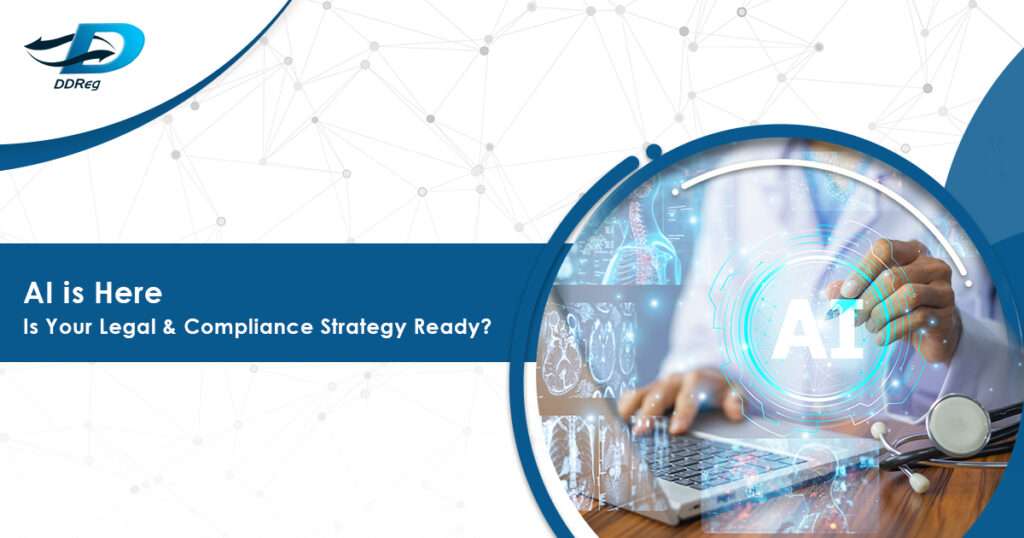
As Artificial Intelligence (AI) rapidly redefines the pharmaceutical processes, it is not just science and operations that are evolving, so are the legal and compliance frameworks that govern them. Once confined to the realm of data science, AI has now become a boardroom priority, demanding urgent attention from legal, regulatory, and compliance professionals. From algorithm-driven regulatory submissions to machine learning models influencing clinical decisions, the pharmaceutical industry’s reliance on AI is deepening and so are the risks.
AI application in pharmaceutical industry refers to the use of advanced algorithms and machine learning techniques to accelerate and optimize drug discovery, development, manufacturing, and patient care. Technologies like machine learning, natural language processing, and robotic process are also increasingly used to analyze data, predict regulatory trends, and ensure timely submissions to regulatory authorities. However, with great power comes great responsibility. The integration of AI introduces new risks related to data privacy, algorithmic transparency, and regulatory compliance. Legal and compliance teams must understand the complexities of AI-driven processes and adapt to rapidly evolving global regulations that are still being developed. This blog explores how the AI is expanding the scope of compliance work, emphasizing key challenges, recent guidance from the FDA, EMA, and MHRA, as well as best practices for professionals in the pharmaceutical industry.
Regulatory Frameworks for AI
As AI technology advances day by day, regulatory authorities are evolving as well. Recent regulatory guidance from agencies is shaping how pharmaceutical companies must approach AI adoption, ensuring that innovation is balanced with robust oversight, transparency, and patient safety.
- US FDA: In January 2025, the U.S. Food and Drug Administration (FDA) released a draft guidance titled “Considerations for the Use of Artificial Intelligence to Support Regulatory Decision-Making for Drug and Biological Products.” The guidance outlines how sponsors can use AI-generated data in regulatory submissions concerning drug safety, efficacy, or quality. Central to this is a risk-based framework for assessing the credibility of AI models based on their intended use.
- EMA: In September 2024, the European Medicines Agency published a Reflection Paper on AI’s role throughout the medicinal product lifecycle. It spans discovery to post-market surveillance, urging developers to meet EU legal standards on AI and data protection. The EMA promotes a proactive, risk-based approach and stresses that AI tools must remain transparent, validated, and under ongoing oversight.
- MHRA: In April 2024, the UK’s MHRA outlined a strategic approach to AI in healthcare. It sets out five principles: (1) Safety/Security – AI systems must be robust and continuously risk-managed; (2) Transparency – AI must be explainable to users; (3) Fairness – AI should not discriminate, urging use of bias-standards; (4) Accountability – clear governance and traceability; (5) Contestability – users should be able to challenge harmful AI decisions, with strengthened reporting (e.g. UK’s Yellow Card scheme for AI device incidents).
Additionally, regulatory authorities are coordinating globally. For example, the FDA, MHRA, and Health Canada have jointly released guiding principles on Predetermined Change Control Plans (PCCPs) to manage AI/ML software updates. This reflects a common focus on traceability and audit-ready AI.
Navigating the Legal and Compliance Risks
As AI permeates every facet of drug development, compliance teams must confront a new set of complex risk areas—including transparency, data privacy, bias, and global regulatory divergence—each demanding specialized strategies and proactive oversight.
- Transparency & Explainability
Regulatory authorities require insights into how AI decisions are made. Under the FDA’s credibility framework, sponsors must demonstrate that an AI tool behaves consistently across varied datasets. To meet this need, pharmaceutical companies are adopting Explainable AI (XAI) to ensure interpretability and meet regulatory expectations from regulatory authorities.
- Data Privacy & Protection
AI systems rely on vast quantities of data—raising concerns under laws like the General Data Protection Regulation (GDPR) and HIPAA. While GDPR requires explicit consent for personal data processing, HIPAA allows certain exceptions for healthcare use. Many companies are piloting federated learning to train AI models without moving sensitive data, reducing privacy risks. Still, safeguards like encryption, pseudonymization, and role-based access control remain essential.
- Bias Detection & Mitigation
Bias in AI can often stems from imbalanced training data or flawed model design. To address this, companies are now integrating bias detection protocols, such as subgroup performance analyses and routine audits, to ensure fairness.
- Global Regulatory Divergence
Compliance teams must manage varying requirements across regions, as harmonization efforts continue but differences persist.
AI is also transforming compliance monitoring from manual, automatic processes to real-time, automated systems. AI-powered platforms can detect anomalies, predict risks,helping companies manage compliance in real time.
Conclusion
AI is expanding the scope of legal and compliance responsibilities in the pharmaceutical industry. As AI adoption accelerates, regulatory agencies worldwide are actively developing guidelines to ensure that AI applications in pharma are safe, effective, and ethically sound. Introducing AI in the pharmaceutical industry will ease the processes for sponsors and regulatory authorities as well as assist in fast tracking medicines into the market. By embracing these evolving standards and fostering cross-functional collaboration, the pharmaceutical industry can harness AI’s potential to enhance patient safety, accelerate innovation, and build a more transparent, ethical, and resilient healthcare ecosystem.
About DDReg
DDReg Pharma is a trusted global partner offering end-to-end regulatory, pharmacovigilance, and compliance solutions. With deep expertise in AI-integrated regulatory strategies, we help pharmaceutical companies navigate evolving global frameworks and accelerate product approvals.
Read more about AI in pharmaceutical drug development from our experts here: Regulatory Challenges and Opportunities with AI in Drug Development
